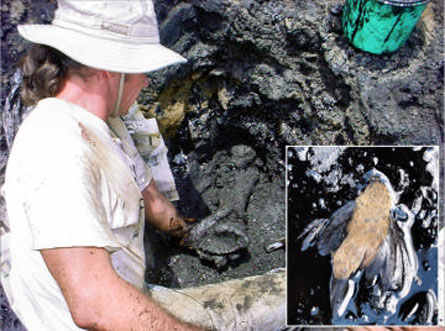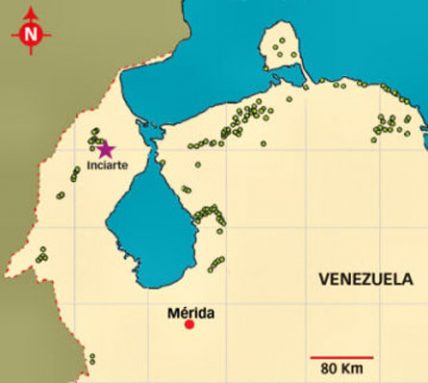South America’s sticky tar pits
The fossil-rich tar pits of Venezuela may rival those in Southern California
By Sid Perkins
 |
|
The menes of Venezuela have claimed many lives, evident in this 25,000-year-old fossil found near Inciarte and the more recent remains of a songbird found at Orocual (inset).
|
| Rincón |
Los Angeles’ Rancho La Brea is one of the world’s most famous fossil-bearing sites. Its tar pits, or sticky pools of asphalt, have yielded more than 1 million fossils. They include 50 mammal species, 125 types of birds, and dozens of reptiles, insects and other invertebrates. But L.A.’s claim to fossil fame could someday soon be equaled or surpassed by tar pits far south of the U.S. border.
Hundreds of oil seeps, also called menes, dot the landscape in Venezuela. They are thousands of miles from Rancho La Brea. Explorers have known about these sites, which trap animals with their stickiness, for more than 400 years. But paleontologists have only just begun to conduct serious digs there in the past 10 years or so.
These South American sites are important for several reasons. First, the Venezuelan menes are found in a variety of ecosystems, scientists note. So their sediments may hold more types of creatures. Second, these sites are located near to where the Isthmus of Panama joins North America with South America. So fossils in the menes hold may shed light on the migrations of creatures to and from South America.
Excavations at one mene site suggest that its oil-rich sediments — and the creatures that they’ve trapped — accumulated over a much longer period of time than those at Rancho La Brea. Thus fossils entombed at this menes sight might yield insights into how and when climate changed as Earth slipped in and out of recent ice ages.
Sticking points
Tar pits form where crude oil from petroleum-rich strata, or rock layers, moves through cracks in overlying strata to Earth’s surface. The lighter components of that oil quickly vaporize. This leaves behind a goo rich in asphalt (the same material used to pave roads). That asphalt can mire even the strongest creature. In northern South America, tar pits can be found in a swath that stretches from the northeastern coast of Venezuela to Peru and Ecuador, says David M. Orchard. He’s a geologist with the oil company ConocoPhillips in Houston.
So far, very few of these menes have yielded fossils or been studied in depth, says Orchard. In the 1950s, Canadian researchers excavated fossils at Peru’s Talara site and Ecuador’s La Carolina site. At both of these locations, scientists found many fossils of birds. They also found canids, a group of mammals that includes dogs, wolves and foxes.
Now, however, scientists are very excited about fossils found in a tar pit near Inciarte. This is in northwestern Venezuela. That mene, more than 1 kilometer long and 500 meters wide, is at least 10 times the size of any of the tar pits at L.A.’s Rancho La Brea, says Orchard.
Despite this big size, scientists have removed only about 1.5 cubic meters of sediment, or around 15 wheelbarrow loads, from the site. From this material, Orchard and his colleagues already have identified the remains of more than 100 species. These include 43 mammals, 56 birds, 11 lizards and 4 frogs. That species tally renders Inciarte the most fossil-rich site in northern South America.
Orchard and his colleagues have carbon-dated some of the Inciarte fossils. And they range between 25,000 and 27,000 years of age. That means they came from a few millennia before the height of the last ice age.
 |
|
Green dots on this map of western Venezuela depict the locations of petroleum seeps, or menes. One fossil-bearing tar pit lies near Inciarte in the far western part of the country.
|
| Rincón |
The Inciarte excavations have produced several revelations about the region’s ancient canids. Researchers have identified fragments of a skull as Urocyon cinereoargenteus, the gray fox, a North American species never before reported to live in South America. Also, teeth and jaw fragments of an extinct species known as the cave wolf have turned up at Inciarte. This creature is known to have lived only in South America and previously was found only at sites at least 1,500 km farther south of Inciarte.
“At Inciarte, there’s a commingling [mixing] of what are typically thought of as North American and South American species,” says Christopher A. Shaw. He is a vertebrate paleontologist at the Natural History Museum of Los Angeles County. At the South American site, the ground sloths, camels and other species characteristic of ancient South America lived alongside the dire wolves and saber-toothed cats typically associated with Rancho La Brea and other North American sites.
“We know a lot about the species in North American and in Argentina,” says Ascanio D. Rincón, a paleontologist at the Venezuelan Institute of Scientific Investigations in Caracas. “In the middle, we know almost nothing about what happened.”
Riches of eastern Venezuela
Like the area near Inciarte in northwestern Venezuela, the Maturín Basin in the eastern part of the country is dotted with scores of menes. In 2006, workers digging a pipeline there unexpectedly began to excavate oil-rich sediments that were chock-full of bones. Although the fieldwork at the site, dubbed El Breal de Orocual, was rushed and wasn’t as systematic as it could have been, early results are promising.
Paleontologists have so far identified the fossils of more than two dozen species, says Rincón. The presence of semiaquatic creatures such as caimans and tapirs suggests that the area once was a floodplain or river delta, he notes. However, the remains of creatures such as llamas and glyptodonts — armored armadillos, some species of which grew to the size and weight of Volkswagen Beetles — hint that the area also hosted a savannah. Probably, says Rincón, the mene sat in a swampy area where water helped disguise the deadly tar. Analyses of the Orocual sediments suggest that they were deposited between 1 million and 500,000 years ago.
Orocual “is the first area I’ve seen that can rival Rancho La Brea,” says Shaw, the L.A.-based paleontologist. “The preservation is just wonderful down there, and it’s amazing how well even delicate things like centipedes have been preserved.” Considering the extent of the site, Shaw speculates that it could easily yield hundreds of thousands of fossils.
Although each tar pit may be active for only a few thousand years, just a small sampling of the vast number of menes in Venezuela could provide paleontologists with a fossil record for the region that could extend back more than 2 million years. In contrast, the fossil record at L.A.’s Rancho La Brea stretches back only 40,000 years or so.
“The combination of that age range and the diversity of ecosystems that could be represented in these menes,” Orchard says, “is an extraordinary opportunity for science.”
“The Inciarte site is so rich, there’s more [paleontology] than anyone can do in a lifetime,” says McDonald. “We’re just now beginning a very long and very exciting process.”







